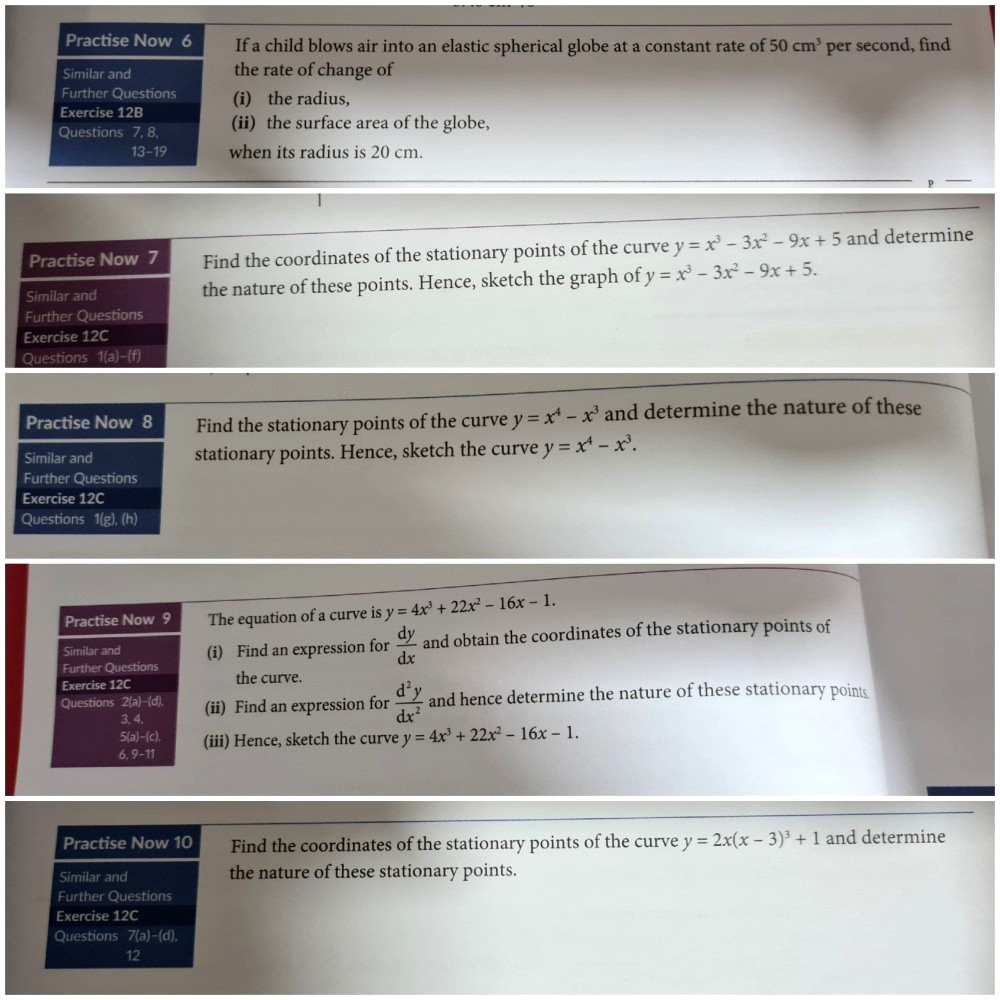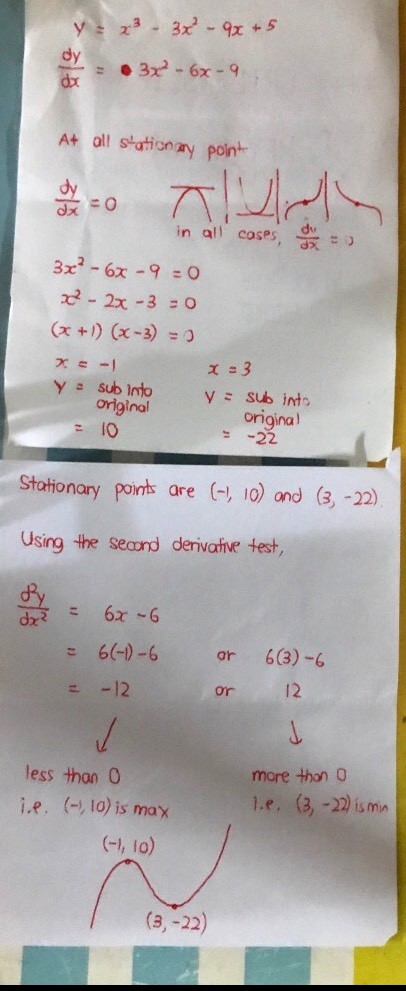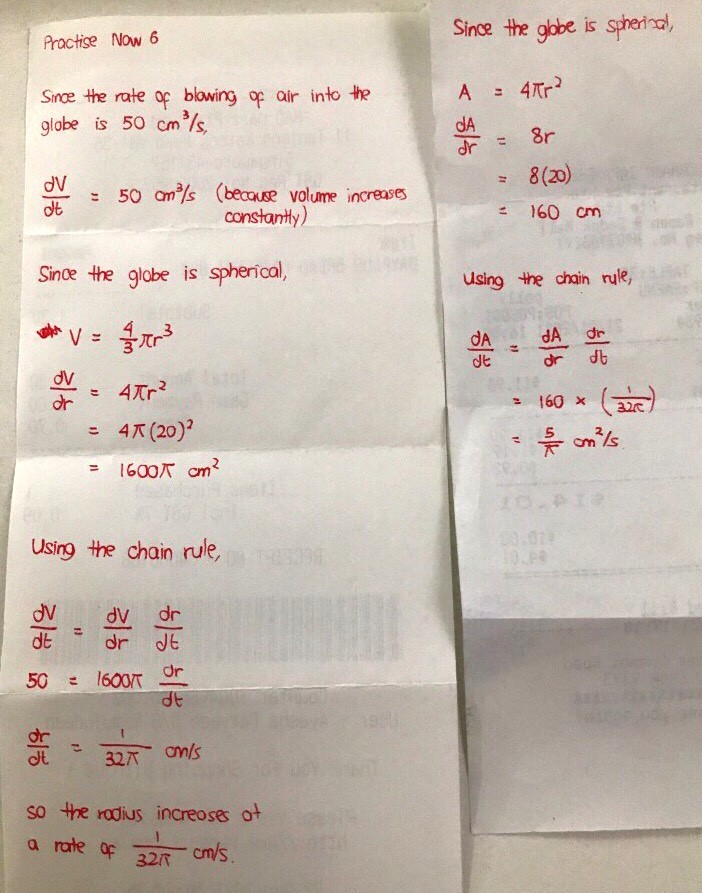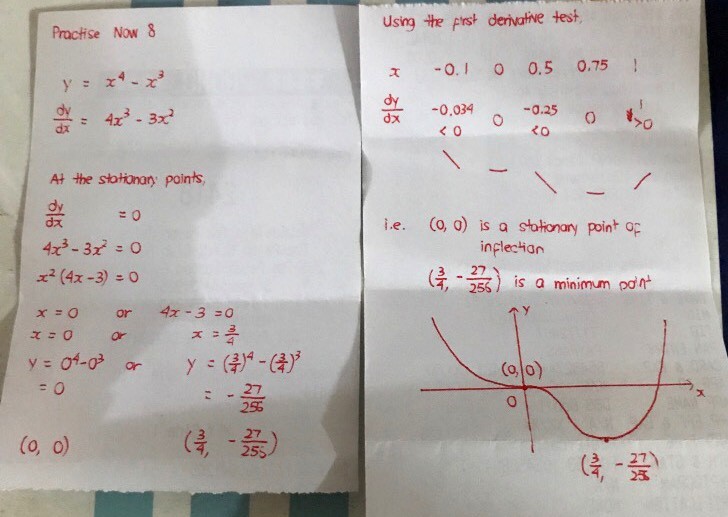Ask Singapore Homework?
Upload a photo of a Singapore homework and someone will email you the solution for free.

Question
secondary 4 | A Maths
4 Answers Below
Anyone can contribute an answer, even non-tutors.

need help with these qns, pls explain too
y = 2x (x - 3)³ + 1
By the product rule and chain rule (the chain to differentiate is the bracketed term x - 3),
dy/dx
= 2x (3) (x - 3)² (1) + (x - 3)³ (2) + 0
= 6x (x - 3)² + 2 (x - 3)³
= 2 (x - 3)² [3x + x - 3]
= 2 (4x - 3) (x - 3)²
At the stationary points, dy/dx = 0, so
2 (4x - 3) (x - 3)² = 0
Then,
4x - 3 = 0 or x - 3 = 0
x = 3/4 or x = 3
y = -2059/128 or y = 1
The stationary points are (3/4, -2059/128) and (3, 1).
Using the first derivative test (we avoid the second derivative test due to the complexity),
(3/4, -2059/128) is a minimum point
(3, 1) is a stationary point of inflection
------------------------------------------------------------
Product rule is used when we face two expressions involving x which are multiplied to one another (such as x² (x - 3)³ or x³ cos x). Of course, we can do product rule on expressions like y = 3x³ itself since 3 and x³ are products of each other, though it's a little too easy in this case.
The formula to use for product rule is
keep first x differentiate second + keep second x differentiate first
So let's say our expression to differentiate is
(2x + 3)³ times (3x - 2)^4.
Then, "first" = (2x + 3)³ while "second" = (3x - 2)^4.
In the formula for the product rule, during the "differentiate first", you would be differentiating (2x + 3)³. If you differentiate this expression, you will soon realise that chain rule must be applied, since that is how you would usually do the question if the question asked you to differentiate (2x + 3)³ as a stand-alone question.
So, in the expressions "differentiate first" and "differentiate second", chain rule continues to apply.
If you are not confident, write the d/dx (2x + 3)³ as a side working elsewhere and differentiate it first before you put the result back into the original expression.
This also applies for the quotient rule - the chain rule must be considered as well.
See 4 Answers
I should be more free to look at the questions within the next two days
also dont really understand what is going on there....
One is by checking the signage of the values of dy/dx around the turning point, just before the turning point and just after the turning point. This is called the first derivative test (i.e. testing for the first derivative dy/dx) and it’s like a visual inspection of the turning point by considering the slopes around the turning point.
The other is by checking the signage of the value of d2y/dx2 at (not around) the turning point itself. This is called the second derivative test (i.e. testing for the value of the second derivative d2y/dx2).
A positive value for d2y/dx2 implies a minimum point. A negative value for d2y/dx2 implies a maximum point.
However, if the value of d2y/dx2 is zero, then the result will be inconclusive (it can be any of the cases). In this case, the second derivative test is said to have failed and as such we would need to use the first derivative test instead. Fortunately, in the vast majority of the cases, the second derivative test works.
Second derivative test is preferred when an expression is relatively easy to differentiate (eg if y = 2x2 - 4x + 3, then dy/dx = 4x - 4 and d2y/dx2 = 4, telling us immediately that the stationary point at x = 1 is a minimum point), while the first derivative test is preferred when an expression looks difficult to differentiate.
does that mean we can use the second derivative test for any questions that require us to find the nature of the roots, unless d2y/dx2=0 or we find dy/dx difficult to differentiate?
-----------------------------------------------
A minimum point occurs when a graph goes down to a lowest point before rebounding up again, while a maximum point occurs when a graph goes up to a highest point before returning down.
A point of inflection which heads upwards is a case where a graph goes up, then slows down to a halt, but instead of returning down afterwards, the graph continues upwards. A similar analogy applies for a point of inflection which heads downwards.
Think of it as a 2.4 km run. Supposing someone is tired. He can walk. Or he can momentarily stop for a while. Of course, after resting, he proceeds forward towards the finish line again and not return backward to the starting point. This is what it means by a point of inflection - go forward, stop, go forward again.
-----------------------------------------------
"does that mean we can use the second derivative test for any questions that require us to find the nature of the roots, unless d2y/dx2=0 or we find dy/dx difficult to differentiate?"
-----------------------------------------------
Both are just different ways of obtaining a turning point - either can be done. The second derivative test is more commonly done when a function appears easy to differentiate. The first derivative test is more commonly done when a function appears tough to differentiate or the second derivative test fails (gives a value of 0).
For the other questions, I explain only if I have time, but my schedule is extremely tight at the moment so I may take a few days to respond.
-----------------------------------------------
Actually no - in fact, it's even better!
If let's say d²y/dx² = 4 when dy/dx = 0 (such as the case of curves like y = 4x² - 8x + 1), then we are certain that the stationary point must be a minimum.
This is because d²y/dx² is already a certain number and we are able to tell immediately whether that number is positive or negative. The only exception to this is when d²y/dx² = 0 when 0 is neither positive or negative, so in this special exception, the second derivative test becomes ambiguous (and therefore fails).
In most cases where d²y/dx² is an expression involving x (for example, d²y/dx² = 6x - 4, arising from y = x³ - 2x² - 2x + 1), then the value for d²y/dx² will have to depend on the values of x.
Reacting ammonia with an acid will not get us ammonia gas; instead, it will get us an ammonium salt since this is essentially a neutralisation reaction
Yes, ammonium salt is formed by the reaction of the alkaline ammonia with an acid.
You need an anion which is like Cl or something to react with ammonia.
There are other cases too, such as aqueous ammonia (NH3 or NH4OH) reacting with things like aluminium chloride, a salt.
This is a precipitation reaction since the metallic hydroxide formed is poorly soluble in water.
by the way does changes in pressure affect the final yield of ammonia in haber process?
When the pressure is increased, the yield of ammonia increases. It’s a little complicated, but the reason for this is A Level stuff.
Basically, if you balance the equation N2 + 3 H2 <==> 2 NH3, we have four moles of reactants versus two moles of products, and there is a rule in A Level saying that an increase in pressure will favour the forward reaction N2 + 3 H2 ==> 2 NH3 since pressure favours the side with the greater number of moles of gases to proceed with reaction.
3F2(g) + 2Fe(s) -> 2FeF3(s)
the equation shows that fluorine acts as an oxidising agent. Use ideas about oxidation state and electron transfer to explain why this state is true
how do we present the answer here? dont really know what to talk about here as it is my first time encountering this... really appreciate your help :)
In the process, elemental iodine will be formed as I2 (aq). KI solution is a colourless solution while I2 solution is brownish, and hence we observe this colour change.
The rules of oxidation states/numbers are as follows.
1. Elements (whether mono atomic or multi atomic) are assigned oxidation numbers of zero
2. Compounds are assigned overall oxidation numbers of zero, but individual elements in the compound might not be zero
In this case, the F in F2 is assigned an oxidation state of 0 (since F2 is a single element molecule) and the Fe in Fe is assigned an oxidation state of zero. For the FeF3, each F is assigned an oxidation state of -1 (because it forms a multi-elemental compound) while Fe is assigned an oxidation state of +3 (to keep the overall oxidation state of the compound zero).
Observe that the oxidation state of F decreases from 0 to -1, so F is reduced and F2 is therefore an oxidising agent. Similarly, the oxidation state of Fe increases from 0 to +3, so Fe is oxidised and Fe is therefore a reducing agent.
So, this is what we can say.
“The oxidation state of F decreases from 0 in F2 to -1 in FeF3 while the oxidation state of Fe increases from 0 in Fe to +3 in FeF3. As such, F gets reduced and is therefore an oxidising agent while Fe gets oxidised and is therefore a reducing agent.”
The coefficients (for balancing the equation) will not be needed when we talk about oxidation states.
Alternatively, in terms of electron transfer, we know that each F in F2, being from group VII, gains an electron from Fe which will donate three electrons per atom.
So, F gains electrons and is therefore reduced (so it is an oxidising agent) while Fe loses electrons and is therefore oxidised (so it is a reducing agent).
F is a non-metal and it gains electrons to form ions.
This comes from the atomic structure and chemical bonding topics.
In this case, the quantities which are clearly linked to each other are volume and radius (because we are talking about air being blown into a sphere and the volume of a sphere is obviously a function of its radius!).
So, it becomes clear that we need to link the volume of the sphere to its radius as follows,
V = 4/3 times πr³
--------------------------------------------------------
Now, we need to find an expression for the rate of change of the radius with respect to time, which is called dr/dt. To do this, we need to obtain expressions for dV/dt and dV/dr before making the linkage.
The connection here between the three terms is dV/dt = dV/dr times dr/dt.
-------------------------------------------------------
dV/dt is already given in the question as 50 cm³/s, so what is now left is to find an expression for dV/dr when the radius r is 20 cm.
So, we need to differentiate our expression for V.
V = 4/3 times πr³
dV/dr = 4πr²
When r = 20 cm,
dV/dr = 4π (20)²
dV/dr = 1600π cm²
-------------------------------------------------------
Now, we have all that we need.
dV/dt = 50 cm³/s
dV/dr = 1600π cm²
Finally, we use the equation
dV/dt = dV/dr times dr/dt
50 = 1600π times dr/dt
And we obtain
dr/dt = 1 / (32π) cm/s
so the rate of change of r with respect to time is 1 / (32π) cm per second.








